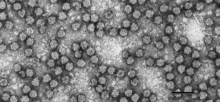Nanoviridae is a family of viruses.[1] Plants serve as natural hosts. There are currently 12 species in this family, divided among 2 genera and one unassigned species.[2] Diseases associated with this family include: stunting.[2][3][4]
| Nanoviridae | |
|---|---|

| |
| Faba bean necrotic yellows virus (FBNYV), genus Nanovirus | |
| Virus classification | |
| (unranked): | Virus |
| Realm: | Monodnaviria |
| Kingdom: | Shotokuvirae |
| Phylum: | Cressdnaviricota |
| Class: | Arfiviricetes |
| Order: | Mulpavirales |
| Family: | Nanoviridae |
| Genera | |
Taxonomy
editThe recognized genera are:
The unassigned species is Coconut foliar decay virus.[2]
Virus structure and genome
editViruses in the family Nanoviridae are non-enveloped, with icosahedral and round geometries, and T=1 symmetry. The diameter is around 18–19 nm.[2][3]
| Genus | Structure | Symmetry | Capsid | Genomic arrangement | Genomic segmentation |
|---|---|---|---|---|---|
| Nanovirus | Icosahedral | T=1 | Non-enveloped | Circular | Segmented |
| Babuvirus | Icosahedral | T=1 | Non-enveloped | Circular | Segmented |
Life cycle
editViral replication is nuclear. Entry into the host cell is achieved by penetration into the host cell. Replication follows the ssDNA rolling circle model.[3] After infection of a host cell, the small DNA molecules that have become encapsidated with the genomic ssDNA act as primers. They bind to complementary regions and help in initiation of DNA synthesis by host polymerases. On completion of synthesis, there will be a double stranded intermediate that is transcribed unidirectionally. Most individual nanovirus particles only encode for a single protein. DNA-templated transcription is the method of transcription. The virus exits the host cell by nuclear pore export, and tubule-guided viral movement. Plants serve as the natural host. The virus is transmitted via a vector (aphids).[2][3]
| Genus | Host details | Tissue tropism | Entry details | Release details | Replication site | Assembly site | Transmission |
|---|---|---|---|---|---|---|---|
| Nanovirus | Plants: legumes | Phloem | Viral movement; mechanical inoculation | Secretion; viral movement | Nucleus | Nucleus | Aphids |
| Babuvirus | Plants: musa species | Phloem | Viral movement; mechanical inoculation | Secretion; viral movement | Nucleus | Nucleus | Aphids |
References
edit- ^ Thomas, JE; Gronenborn, B; Harding, RM; Mandal, B; Grigoras, I; Randles, JW; Sano, Y; Timchenko, T; Vetten, HJ; Yeh, HH; Ziebell, H; ICTV Report Consortium (12 January 2021). "ICTV Virus Taxonomy Profile: Nanoviridae". The Journal of General Virology. 102 (3). doi:10.1099/jgv.0.001544. PMC 8515864. PMID 33433311.
- ^ a b c d e "ICTV Report Nanoviridae".
- ^ a b c d "Viral Zone". ExPASy. Retrieved 15 June 2015.
- ^ ICTV. "Virus Taxonomy: 2014 Release". Retrieved 15 June 2015.
External links
edit- ICTV Report Nanoviridae
- Boettcher, Stefan; Percus, Allon (2000). "Nature's way of optimizing". Artificial Intelligence. 119 (1–2): 275–286. arXiv:cond-mat/9901351. doi:10.1016/S0004-3702(00)00007-2. S2CID 7128022.
- Notes on Nanoviridae
- Viralzone: Nanoviridae